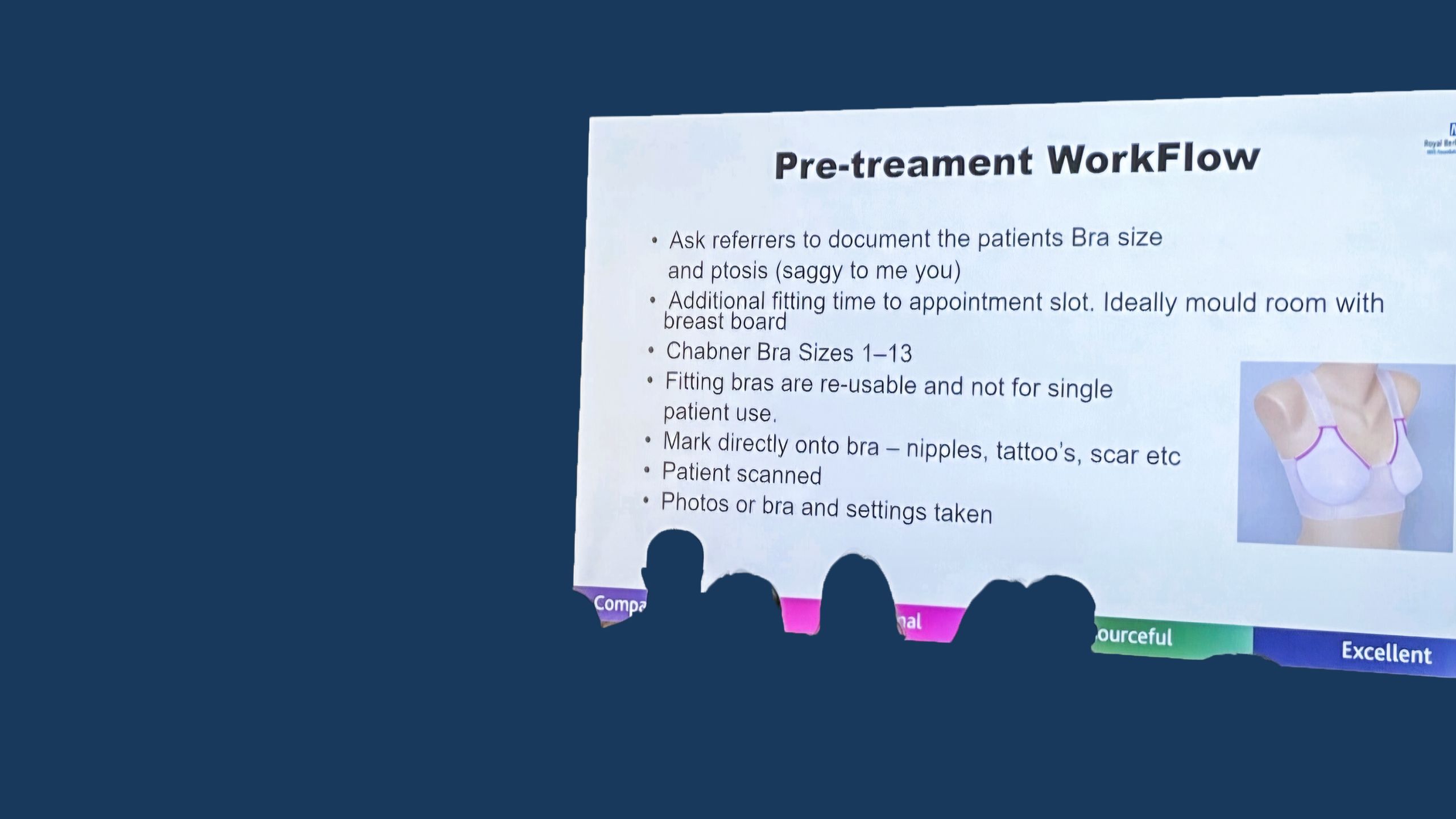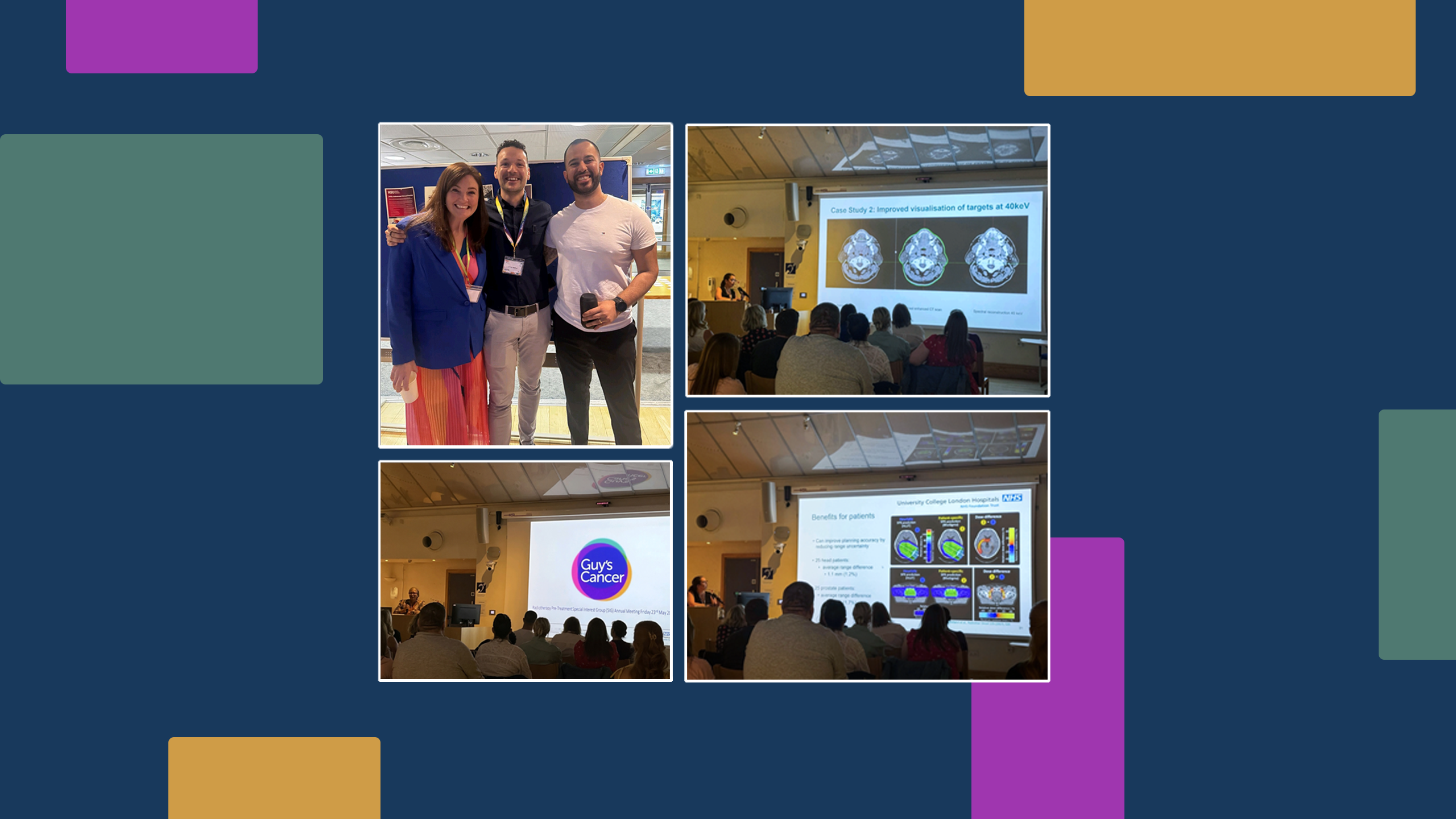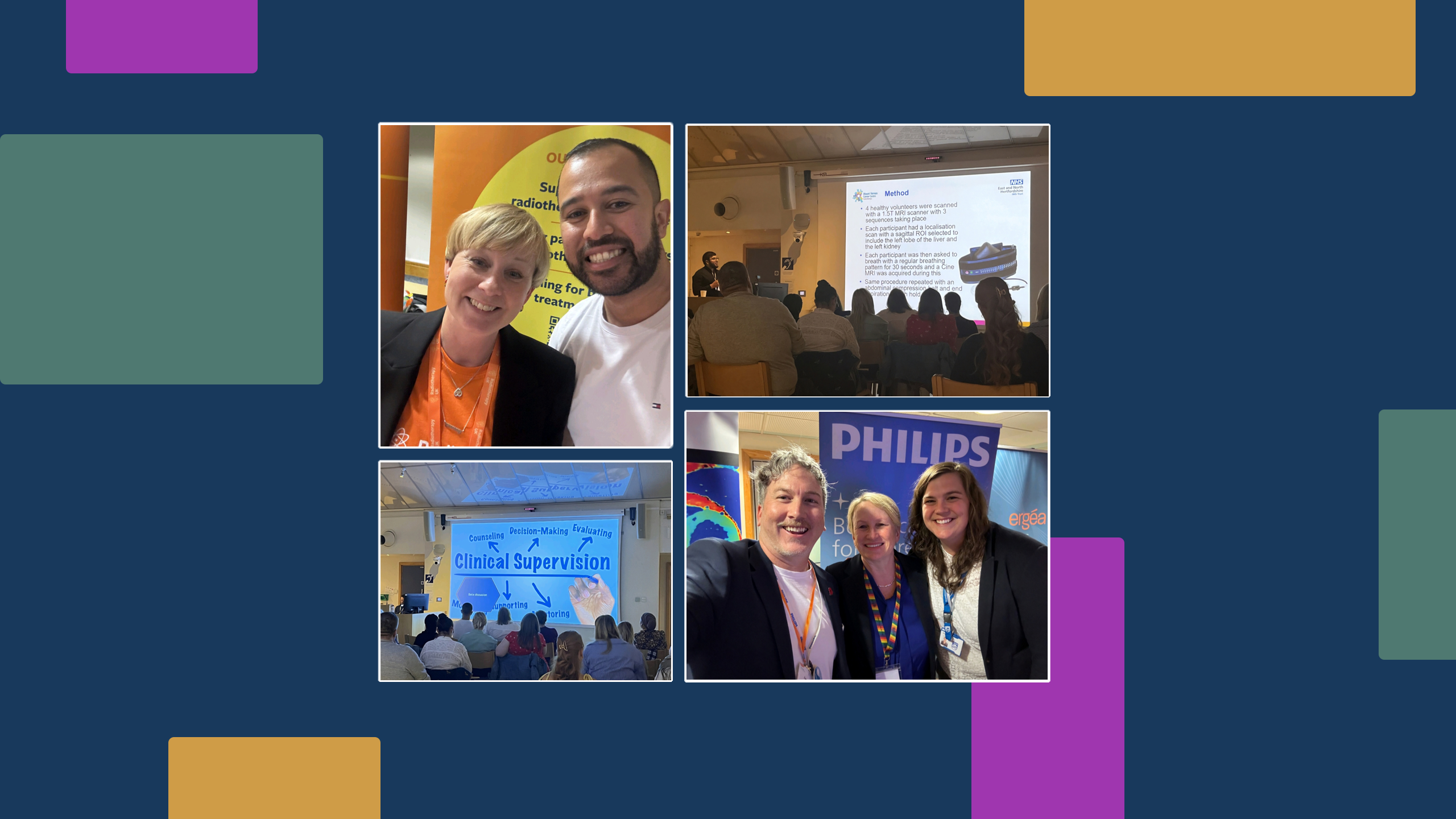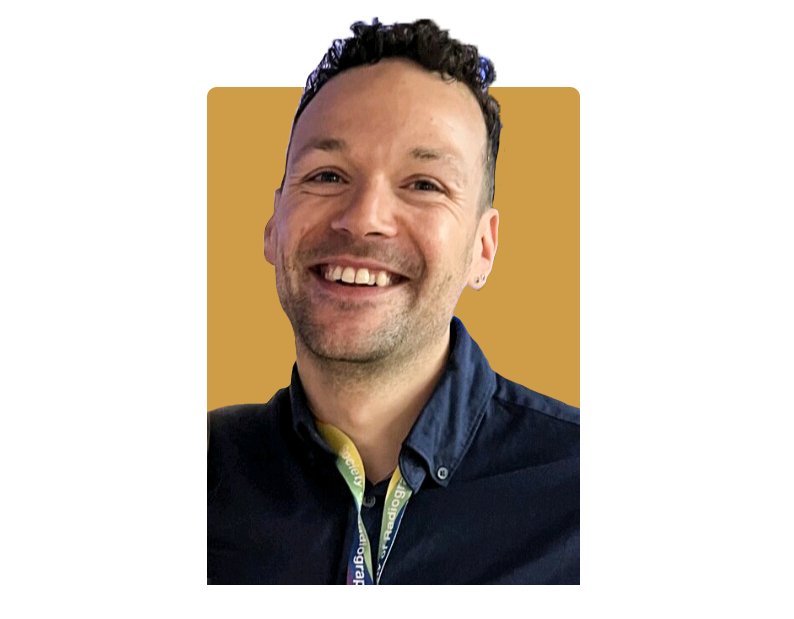‘These are really passionate radiographers’: inside the 2025 Radiotherapy Pre-Treatment SIG annual meeting
From raising awareness to showcasing new technologies, Synergy rounds up the highlights of the event and catches up with attendees

James Barber
James Barber
A common opinion among attendees at this year’s Radiotherapy Pre-Treatment SIG annual meeting was just how engaged the audience was. Almost 100 people filed into the Atrium at the Royal Free Hospital in May for the group’s second-ever annual meeting, which saw a number of top radiography professionals deliver presentations on pre-treatment studies and techniques.
The CPD Now-endorsed meeting was organised by James Barber, chair of the Radiotherapy Pre-Treatment SIG, a radiotherapy pre-treatment superintendent and chair of the SoR’s LGBTQI+ Equalise Workers Group. “Organising the conference has been a lot more work than I ever thought,” he said. “I see why people hire events teams now! But it is really good to see so many people here.
“I thought there’d be about 20 pre-treatment nerds like me. But there’s nearly 100 people here, and they all seem really engaged.”
James delivered one of the opening talks of the day, welcoming attendees and emphasising the importance of sharing knowledge to help the group “find out better ways to do things”. Clare Hartill, head of radiotherapy at the Royal Free Hospital, and Josh Imber, technical support manager at Oncology Imaging Systems, also conducted opening talks, as did Charlotte Beardmore, the SoR's executive director for professional policy.
Charlotte encouraged attendees to look into other SIGs on offer, and addressed cuts across the health service. “We continue to lobby for investments in new placements and new ways of working,” she said.
Lifting others up through education
The first portion of the day was dedicated to breast cancer pre-treatment – namely, improving radiographer practice and developing techniques. Ruth Williams, a consultant Therapeutic Radiographer specialising in breast cancer, delivered the first presentation on the schedule. It centred on the role of the consultant radiographer in clinical practice, and how this relates to the pre-treatment process. She said she is a “massive advocate” of clinical supervision – however, she believes that clinical supervision is not mentorship. “For me, I encourage radiographers to bring problems to the table so we can work through them in a way that is solutions focused,” she told the audience. Ruth explained that supporting radiotherapy in practice can consist of bringing in one-to-one-style training. “More importantly, I focus on ‘why do we do what we do? I try to lead people through problems so they can come to their own solutions.”
Speaking to Synergy later, Ruth said she hoped that the theme of educating those around us came across in her presentation. “For me, professional leadership and expertise and education and training – these are things that are interlinked,” she continued. “We can’t – for me – spend all our time living in the expert practice element of the four pillars.
“We have to educate others, we have to bring other people’s knowledge up, we have to succession-plan our career. For me, that comes from the education and the training.”
The breast cancer session consisted of four speakers. Along with Ruth, Mariama Adams-Saani, Sophie Main and Wendy Goldshaker delivered presentations.


Technological advances on display
Sophie’s presentation on the Chabner bra was a particular stand-out for attendees, who talked about it throughout the day. She discussed breast immobilisation at the Royal Berkshire Cancer Centre, and outlined how a Chabner bra is used to scan patients there. Previous practice at the centre was to use a thermoplastic band-style contraption across both breasts. She detailed how the Chabner bra is compatible with any immobilisation device, and that there are fewer re-scans when using the bra.
“I’ve liked seeing the technological advances,” said Charlotte. “The Chabner bra was very interesting for me in terms of really helping immobilisation for some categories of breast [cancer].”
Reflecting on the day, she told Synergy: “As a previous pre-treatment radiographer, it’s fantastic to be back in a room again with colleagues and also to learn. It’s been a fantastic day. And a really big thanks to James Barber for all his work in setting up the second annual meeting.”
Raising awareness
There were a number of stands at the back of the atrium showcasing the work of industry partners. Some were advertising radiotherapy equipment – the Chabner bra was on display – while others were run by charities hoping to raise awareness. Lynsey Rice, project manager at Radiotherapy UK, was manning the charity’s stand at the conference. Radiotherapy UK is the UK’s only charity that is committed to fighting for better radiotherapy treatments for patients. “We support the workforce and we support the patients, and we also do a lot of campaigning government to raise awareness of radiotherapy and its benefits,” Lynsey explained.
Though Lynsey was in attendance primarily to raise Radiotherapy UK’s profile, she also benefitted from the conference’s packed itinerary and the opportunities to network. “It’s been really interesting,” she said. “I’ve learned a lot already this morning from the presentations.
“And I’ve managed to engage with some colleagues I worked with years ago as well as introduce new people to Radiotherapy UK.”
Josh represented Oncology Imaging Systems, a medical device company that supported the Radiotherapy Pre-Treatment SIG meeting, and was responsible for supporting the industry side of pre-treatment and generating collaborative ideas among attendees. “What I found today was the need for such events to encourage cooperation with peers and different centres and the different techniques being used, and how, moving forward, they can work together to generate new outcomes,” he explained.


Evoking idea sharing in attendees
Later in the day Amanda Webster delivered another conference highlight: her presentation on a critical review of motion management techniques. “I was absolutely delighted when I was invited to speak on my systematic review,” said Amanda, a research and development specialist Therapeutic Radiographer.
“It definitely was a challenge to turn something that was so data heavy – a published piece of work that has a lot of numbers, a lot of tables, a lot of high-level methods – and try and turn that into a talk that could be more tangible and provoke conversation with the audience.”
Looking at the day itself, Amanda felt the delegates were very engaged with all the content on offer, especially when it came to the Q&A sessions. “People have been picking up on content,” she continued. “Some of the questions from my own piece really made me think and reflect ‘what have I done?’ and consider my data so that we could have an engaging conversation on it.
“I don’t know if it’s because of the set up in this particular room and how it is – it’s just a really great balance of not too overwhelming, but [it] also feels real and complete and really engaging [for] audience members. They are making it, I think, as well. Not just the speakers, but the audience too.”

Networking opportunities
One attendee who found Amanda’s presentation a highlight was Therapeutic Radiographer Liam Wiles, pre-treatment superintendent radiographer and associate head of radiotherapy at Barts Health NHS Trust. Liam also participated in the conference line up himself by chairing a Q&A panel on SABR in pre-treatment. “James invited me to chair one of the panel discussions, which actually I’ve never done before,” Liam admitted. “I was a little anxious about it, but it’s a subject that I come across at work in daily practice, so it was really interesting to hear the answers.”
James joined Liam on the panel, as did Catriona Buchan, radiotherapy advanced practitioner (pre treatment) at Leeds Cancer Centre, and Samantha Bennett, clinical service lead for radiotherapy at GenesisCare. While the content of the meeting was obviously the event’s main selling point, Liam pointed out that the opportunity to network and engage with attendees who work in similar environments to you was invaluable. “Just having the opportunity to reconnect with people you may have worked with in the past, but also meet new people and ask: ‘What do you guys do when you… what’s this, what’s this?’ It’s those informal professional networking discussions that are sometimes really productive.”
Audience engagement
With so much content on offer from so many professionals, attendees had a lot to take in. But this didn’t stop them from engaging and sharing their thoughts. Ruth thought the audience was ”massively engaged”.
“These are really passionate radiographers,” she said. “These are people who are trying to bring innovation into clinical scenarios that are underresourced and understaffed.”
The idea of submitting questions online allowed for even more engagement. Charlotte pointed out how many attendees used the Slido system to submit questions, which were considered alongside in-person questions. “I think the audience was amazing,” she said. “Sometimes the Q&As are slow to get going. I popped on to Slido [an app that enables conference audiences to engage with live presentations] – which James had also set up – and there were already some flowing questions, 10, 15 questions coming up, which was really amazing to see. And also questions from the room – again, really detailed.”
This interest spanned across all the presentations throughout the day, Amanda added. “I think not just for my own presentation, but all presentations, the audience discussions have been fantastic,” she concluded. “We have both the online system and the microphone so people – depending on how comfortable they are – can put it in the chat or they can speak up.”
More about the Radiotherapy Pre-Treatment SIG
The Radiotherapy Pre-Treatment SIG is chaired by James Barber. The group has an active web forum on Synapse that allows for the discussion of new information and techniques in the pre-treatment specialty. The SIG also releases an annual report, the latest of which – along with more information about the group – can be found here.
Read more




